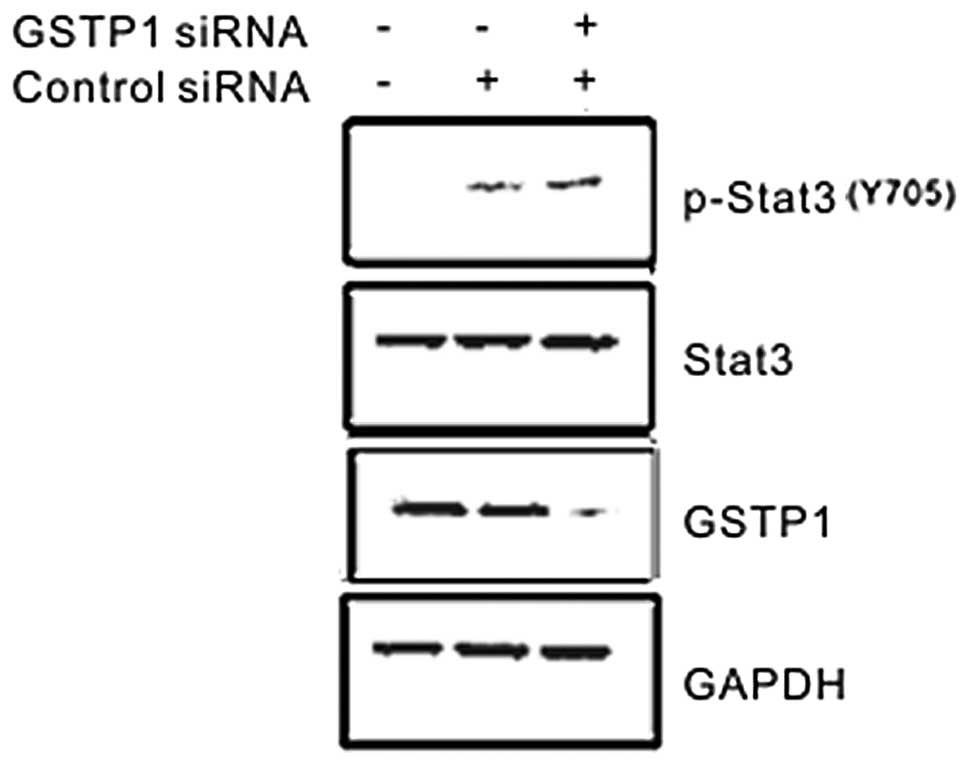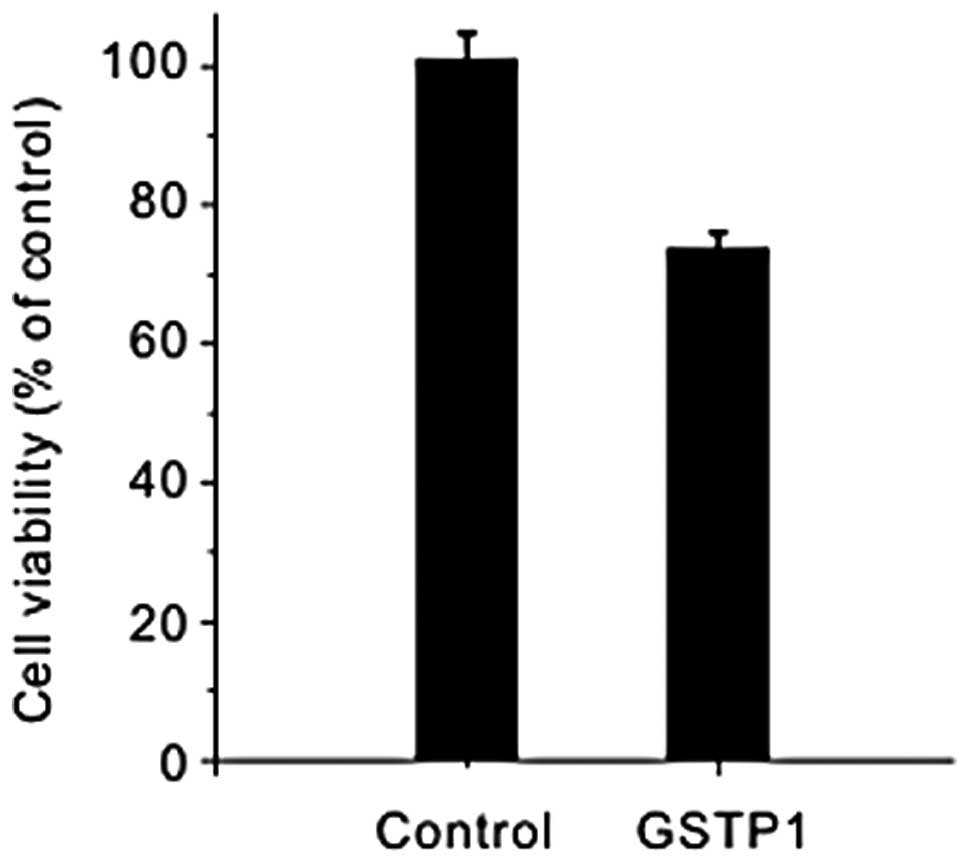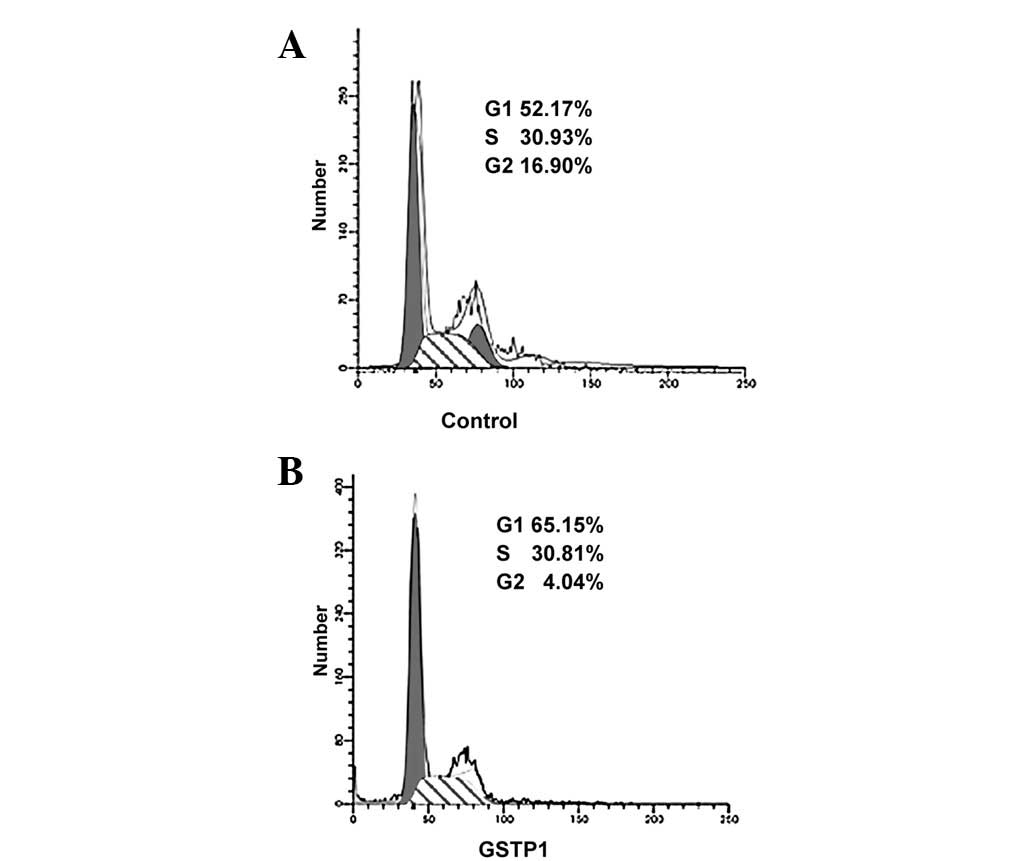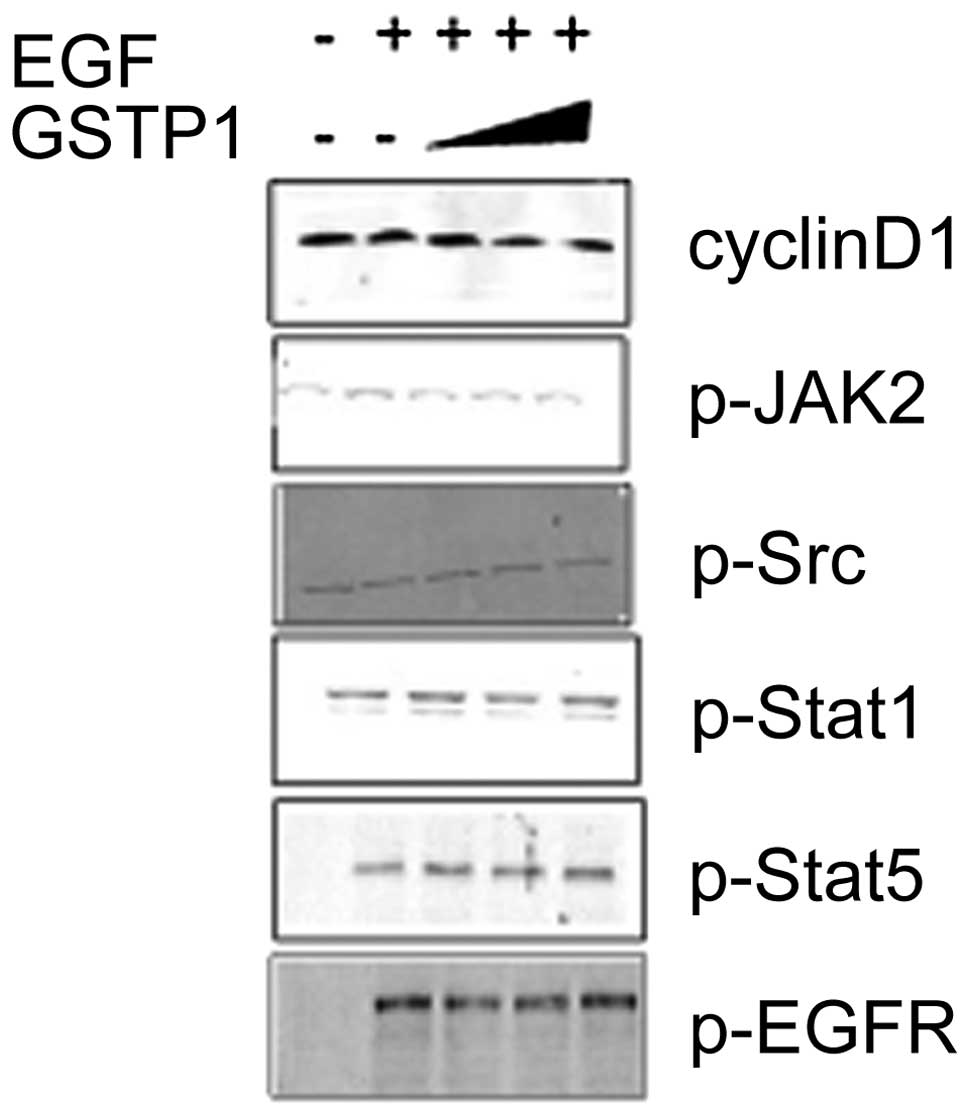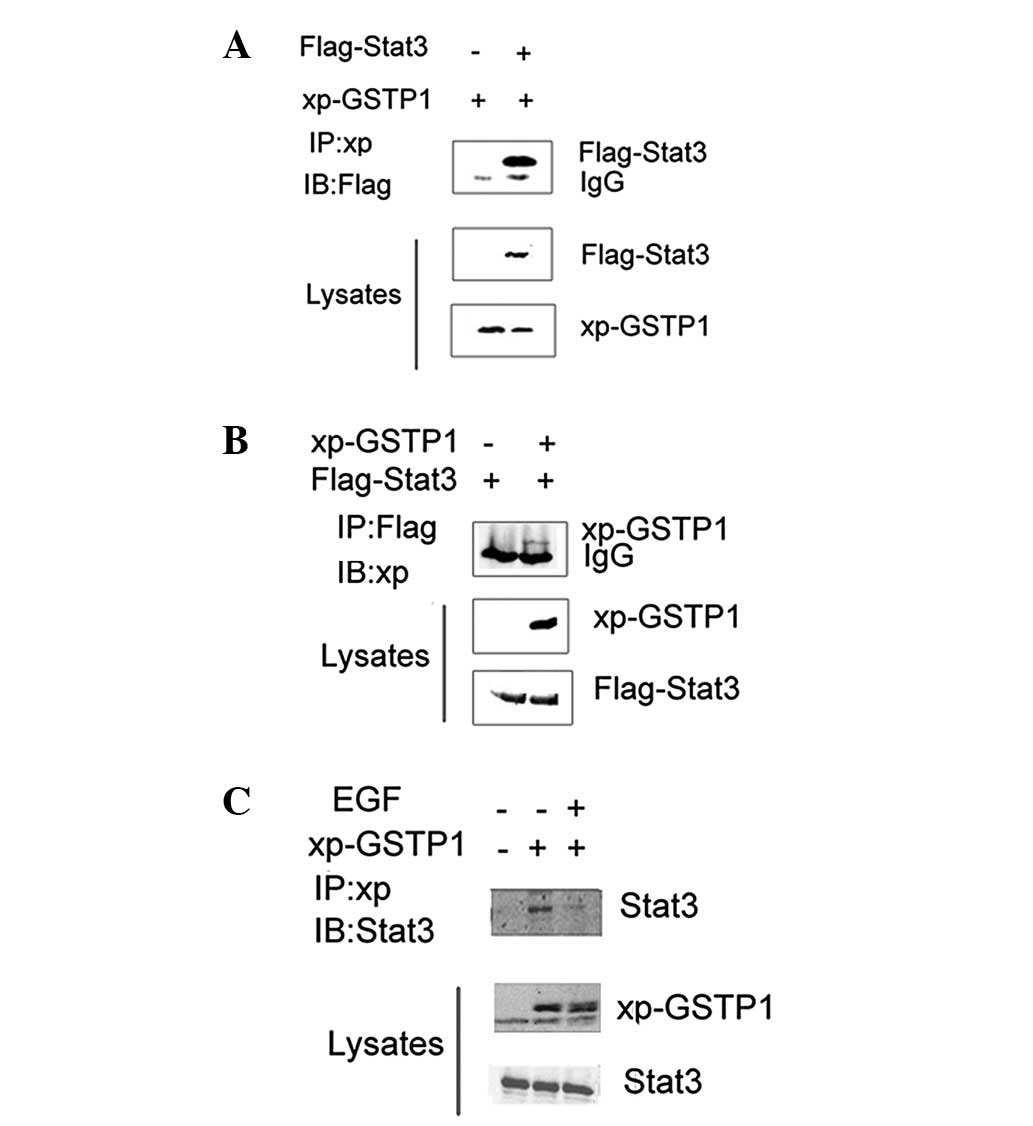|
1
|
Tew KD: Glutathione-associated enzymes in
anticancer drug resistance. Cancer Res. 54:4313–4320.
1994.PubMed/NCBI
|
|
2
|
Townsend D and Tew K: Cancer drugs,
genetic variation and the glutathione-S-transferase gene family. Am
J Pharmacogenomics. 3:157–172. 2003. View Article : Google Scholar : PubMed/NCBI
|
|
3
|
Eaton DL and Bammler TK: Concise review of
the glutathione S-transferases and their significance to
toxicology. Toxicol Sci. 49:156–164. 1999. View Article : Google Scholar : PubMed/NCBI
|
|
4
|
Xue B, Wu Y, Yin Z, Zhang H, Sun S, Yi T
and Luo L: Regulation of lipopolysaccharide-induced inflammatory
response by glutathione S-transferase P1 in RAW264.7 cells. FEBS
Lett. 579:4081–4087. 2005. View Article : Google Scholar : PubMed/NCBI
|
|
5
|
Inoue T, Ishida T, Suqio K, Maehara Y and
Suqimachi K: Glutathione S transferase Pi is a powerful indicator
in chemotherapy of human lung squamous-cell carcinoma. Respiration.
62:223–227. 1995. View Article : Google Scholar : PubMed/NCBI
|
|
6
|
Sato K: Glutathione transferases as
markers of preneoplasia and neoplasia. Adv Cancer Res. 52:205–255.
1989. View Article : Google Scholar : PubMed/NCBI
|
|
7
|
Singh SV, Xu BH, Gupta V, Emerson EO,
Zaren H and Jani JP: Characterization of a human bladder cancer
cell line selected for resistance to BMY 25067, a novel analogue of
mitomycin C. Cancer Lett. 95:49–56. 1995. View Article : Google Scholar : PubMed/NCBI
|
|
8
|
Grignon DJ, Abdel-Malak M, Mertens WC,
Sakr WA and Shepherd RR: Glutathione S-transferase expression in
renal cell carcinoma: a new marker of differentiation. Mod Pathol.
7:186–189. 1994.PubMed/NCBI
|
|
9
|
Zhong S, Tang MW, Yeo W, Liu C, Lo YM and
Johnson PJ: Silencing of GSTP1 gene by CpG island DNA
hypermethylation in HBV-associated hepatocellular carcinomas. Clin
Cancer Res. 8:1087–1092. 2002.PubMed/NCBI
|
|
10
|
Lin X, Asgari K, Putzi MJ, et al: Reversal
of GSTP1 CpG island hypermethylation and reactivation of pi-class
glutathione S-transferase (GSTP1) expression in human prostate
cancer cells by treatment with procainamide. Cancer Res.
61:8611–8616. 2001.PubMed/NCBI
|
|
11
|
Henderson CJ, Smith AG, Ure J, Brown K,
Bacon EJ and Wolf CR: Increased skin tumorigenesis in mice lacking
pi class glutathione S-transferases. Proc Natl Acad Sci USA.
95:5275–5280. 1998. View Article : Google Scholar : PubMed/NCBI
|
|
12
|
Nelson CP, Kidd LC, Sauvageot J, et al:
Protection against
2-hydroxyamino-1-methyl-6-phenylimidazo[4,5-b]pyridine cytotoxicity
and DNA adduct formation in human prostate by glutathione
S-transferase P1. Cancer Res. 61:103–109. 2001.
|
|
13
|
Bromberg J and Darnell JE Jr: The role of
STATs in transcriptional control and their impact on cellular
function. Oncogene. 19:2468–2473. 2000. View Article : Google Scholar : PubMed/NCBI
|
|
14
|
Darnell JE Jr: Transcription factors as
targets for cancer therapy. Nat Rev Cancer. 2:740–749. 2002.
View Article : Google Scholar : PubMed/NCBI
|
|
15
|
Yu H and Jove R: The STATs of cancer - new
molecular targets come of age. Nat Rev Cancer. 4:97–105. 2004.
View Article : Google Scholar : PubMed/NCBI
|
|
16
|
Zhang T, Ma J and Cao X: Grb2 regulates
Stat3 activation negatively in epidermal growth factor signalling.
Biochem J. 376:457–464. 2003. View Article : Google Scholar : PubMed/NCBI
|
|
17
|
Buettner R, Mora LB and Jove R: Activated
STAT signaling in human tumors provides novel molecular targets for
therapeutic intervention. Clin Cancer Res. 8:945–954.
2002.PubMed/NCBI
|
|
18
|
Li F, Fernandez PP, Rajendran P, Hui KM
and Sethi G: Diosgenin, a steroidal saponin, inhibits STAT3
signaling pathway leading to suppression of proliferation and
chemosensitization of human hepatocellular carcinoma cells. Cancer
Lett. 292:197–207. 2010. View Article : Google Scholar : PubMed/NCBI
|
|
19
|
Ruscoe JE, Rosario LA, Wang T, et al:
Pharmacologic or genetic manipulation of glutathione S-transferase
P1-1 (GSTpi) influences cell proliferation pathways. J Pharmacol
Exp Ther. 298:339–345. 2001.PubMed/NCBI
|
|
20
|
Garcia R, Bowman TL, Niu G, et al:
Constitutive activation of Stat3 by the Src and JAK tyrosine
kinases participates in growth regulation of human breast carcinoma
cells. Oncogene. 20:2499–2513. 2001. View Article : Google Scholar : PubMed/NCBI
|
|
21
|
Niu G, Bowman T, Huanq M, et al: Roles of
activated Src and Stat3 signaling in melanoma tumor cell growth.
Oncogene. 21:7001–7010. 2002. View Article : Google Scholar : PubMed/NCBI
|
|
22
|
Ishigaki S, Abramovitz M and Listowsky I:
Glutathione-S-transferases are major cytosolic thyroid hormone
binding proteins. Arch Biochem Biophys. 273:265–272. 1989.
View Article : Google Scholar : PubMed/NCBI
|
|
23
|
Ketley JN, Habig WH and Jakoby WB: Binding
of nonsubstrate ligands to the glutathione S-transferases. J Biol
Chem. 250:8670–8673. 1975.PubMed/NCBI
|
|
24
|
Litwack G, Ketterer B and Arias IM:
Ligandin: a hepatic protein which binds steroids, bilirubin,
carcinogens and a number of exogenous organic anions. Nature.
234:466–467. 1971. View
Article : Google Scholar : PubMed/NCBI
|
|
25
|
Lo HW and Ali-Osman F: Genetic
polymorphism and function of glutathione S-transferases in tumor
drug resistance. Curr Opin Pharmacol. 7:367–374. 2007. View Article : Google Scholar : PubMed/NCBI
|
|
26
|
Naka T, Narazaki M, Hirata M, et al:
Structure and function of a new STAT-induced STAT inhibitor.
Nature. 387:924–929. 1997. View
Article : Google Scholar : PubMed/NCBI
|
|
27
|
Chung CD, Liao J, Liu B, Rao X, Jav P,
Berta P and Shuai K: Specific inhibition of Stat3 signal
transduction by PIAS3. Science. 278:1803–1805. 1997. View Article : Google Scholar : PubMed/NCBI
|
|
28
|
Parkin DM, Bray F, Ferlay J and Pisani P:
Global cancer statistics, 2002. CA Cancer J Clin. 55:74–108. 2005.
View Article : Google Scholar
|
















